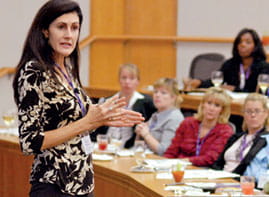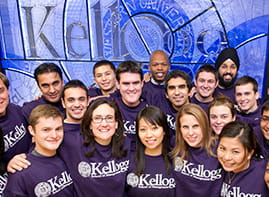Professor David Besanko offers cost-benefit analysis, global perspective on the economics behind a critical U.S. issue during Part-Time MBA Program speaker series
2/8/2008 - Immigration is a thorny public policy challenge for the United States, one that attracts special attention during an election year, when debate surrounding the subject often is driven by emotion rather than data.
But Kellogg School students recently benefited from a reasoned, analytical assessment of U.S.-Mexico immigration dynamics, courtesy of David Besanko ’82, the Alvin J. Huss Distinguished Professor of Management and Strategy.
In a Feb. 1 Thought Leadership Colloquium at Wieboldt Hall, home of the Kellogg Part-Time MBA Program, Besanko marshaled demographic and economic specificity to bring some clarity to a topic that too easily becomes an ideological football.
“I want to go beyond the rhetoric,” Besanko told the Kellogg audience. “My goal is to analyze the economic effects of immigration on the U.S. and Mexico.”
Using research data that included historical surveys and reports from government and other agencies, Besanko cut through the noise to present an overview of immigration — both legal and undocumented — rooted in economic theory, his area of expertise. He presented a similar colloquium to Kellogg alumni in Mexico City in November as part of “Kellogg Insight Live: Global Edition,” the school’s global academic outreach to its alumni. The Wieboldt session was part of a series that includes several other Kellogg professors sharing their expertise on subjects from marketing to finance.
In Besanko’s discussion, he indicated that immigrants from all countries now comprise about 12.5 percent of the U.S. population. By contrast, aggregating over all countries, the foreign-born population as a fraction of the total world population is only about 3.5 percent.
Given these figures, “immigration in the United States clearly matters, and it reflects the U.S.’s historical role as a melting pot,” said Besanko, who is also senior associate dean for academic affairs: planning and external relations at Kellogg.
He went on to examine key demographics, including the reasons why immigrants enter the U.S. (“economic necessity” topped the list of motives for Mexican migrants); where they tend to settle once inside the country (California and New York had the largest share of foreign-born populations in 2000, followed by New Jersey, Hawaii and Florida); and educational profiles of U.S. native and U.S. foreign-born populations. Among the former group, about 22 percent hold bachelor’s degrees. Among those groups born outside the U.S. but apart from Mexico and Central America, some 27 percent hold bachelor’s degrees. Only 5 percent of those emigrating from Mexico and Central America have earned that degree, according to Congressional Budget Office testimony from 2007 that Besanko cited.
Linked to education were earnings data that revealed a significant disparity between male, native-born full-time workers in the U.S. and those from Mexico or Central America. Besanko noted that even when education was similar, native-born workers earned more money, a fact apparent at the lower end of the education scale, but still evident even at the advanced degree level. Workers who came to the U.S. from countries outside Mexico or Central America earned somewhere between the other two groups, although at the graduate-degree level this group nearly equaled the salary of native-born U.S. citizens.
With respect to undocumented immigrants, Besanko produced data from the Pew Hispanic Center estimating that more than 11 million such immigrants resided in the U.S. in March 2005, representing a 40-percent increase since 2000. Altogether, undocumented immigrants constituted about 30 percent of the U.S. foreign-born population of 37 million in 2005. These workers held jobs in a variety of occupations, ranging from service in private households (21 percent) to food manufacturing (14 percent), farming (13 percent), construction (12 percent) hotels (10 percent) and manufacturing (6 percent).
Besanko said that for Mexican immigrants economic incentives were significant: Those working in the U.S. in 2006 with less than an 8th-grade education earned $22,500 per year on average. The same worker in Mexico earned about $5,000 annually.
“In practice, the economic disparity is likely even greater than these figures indicate,” said Besanko, “since immigrants from Mexico come disproportionately from rural areas where wages are lower than average.”
And these earnings are taxed, Besanko said, dispelling a misconception about undocumented immigrants. “Undocumented immigrants do pay taxes,” he said, citing sales and excise taxes as well as the fact that employers withhold federal income taxes from their paychecks. These immigrants even pay the employee portion of Social Security taxes, based on phony Social Security numbers. As of 2004, the fund that contains the proceeds of payroll taxes from non-existent Social Security numbers exceeded half a trillion dollars.
Besanko also reviewed U.S. border enforcement policy, presenting research that indicated current strategies were most likely not deterring significant numbers of rural Mexicans attempting to cross the border.
Although there is some evidence that undocumented immigrants take jobs that U.S. native workers would otherwise not take, recent econometric evidence suggests that immigration has a downward impact on wages, with the magnitude of the impact depending on workers’ education and experience levels. High-school and college graduates were less impacted by the influx of immigrants from 1980 to 2000 than were high-school dropouts.
Besanko pointed out that despite the impact on wages, immigration has a positive net impact on the U.S. economy, though that impact is probably small. A calculation based on a simple economic model suggests that the U.S.’s “immigration surplus” (the net change in national income due to immigration) amounted to $13.08 billion in 2005, or about $49 per U.S. native. This surplus was greater for Mexico, which accrued an estimated $20.7 billion in 2006 ($190 per person per year), in part due to some $23 billion in remittances sent home by Mexicans working in America.
The U.S. surplus, however, is complicated by other factors that Besanko indicated. On the negative side, immigrant consumption of public benefits such as Medicaid imposes a burden on native households of about 0.225 percent of U.S. GDP. But immigrants also likely contribute to the U.S. economy in positive ways that are difficult to measure: For example, immigrants can free up natives for other jobs for which they are more productive, increasing the economy’s overall labor productivity. Immigrants can also bring skills, insights and drive that result in greater innovation and economic growth.
When considering the data holistically and examining its impact on the political debate about immigration, Besanko said: “On economic grounds alone, the U.S. is not politically predisposed to liberalize immigration from Mexico. The gains from undocumented immigration are dispersed and hard for the typical citizen to see, while the costs of immigration in terms of impact on the incomes of low-skill native workers, and the provision of needed public benefits to accommodate immigration, are more keenly felt and thus more visible.”
He also pointed out that emotional reactions to immigration from Mexico complicate the issue further. Yet it is likely that “massive investments in border and worksite enforcement” will be needed to offset the large economic incentives for Mexicans to cross the border and the incentives of employers to hire undocumented workers. Whether such draconian measures will be acceptable to most Americans, however, was a question that remains open. It is likely, suggested Besanko, that an uncomfortable political stalemate on immigration may continue for now.
On the other hand, Mexico has a strong interest in the U.S. liberalizing immigration. According to Besanko, “to advance its interests, the Mexican government will need to make an effort to entice the U.S. government to the bargaining table to have a serious bilateral discussion on immigration.” It is also possible that in the next decade the immigration issue may begin to resolve itself. Besanko pointed to evidence of declining fertility rates in Mexico that suggest Mexico may soon approach the breakeven rate of population growth, a result that may reduce the rate of migration northward.
For Besanko, the chance to discuss “the most important and perhaps most divisive issue between the U.S. and Mexico” was a welcome opportunity.
“It was a real pleasure to speak to the students in a way that goes beyond the political rhetoric and toward a discussion grounded in the facts and in economic analysis,” he said.
The Thought Leadership series is another way the school brings top Kellogg professors to students in the Part-Time MBA Program for discussions of critical issues and opportunities facing global leaders in the 21st century. In November, marketing expert Philip Kotler, the S.Ç. Johnson & Son Professor of International marketing, delivered a colloquium as part of the series. Paul Christensen, senior lecturer of finance, is scheduled to deliver a talk on microfinance May 9 at Wieboldt Hall, and Kellogg Dean Dipak C. Jain will present his marketing and innovation insights in a colloquium this summer.
For more information on these and other events in the Kellogg School’s Part-Time MBA Program, visit the
part-time student intranet.






